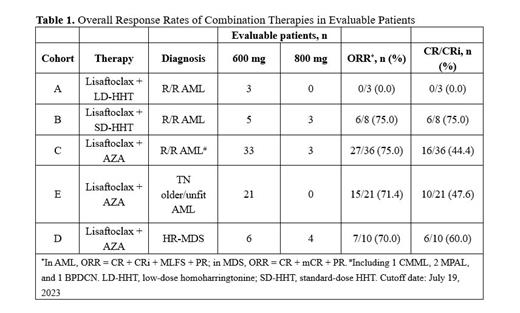Drs. Yifan Zhai and Jie Jin are co-corresponding authors.
Introduction
Investigational lisaftoclax, a novel BCL-2 inhibitor, has shown antileukemic activities in pts with CLL. For the first time, we present the safety, pharmacokinetics (PK), and efficacy of lisaftoclax alone or combined with azacitidine (AZA) or homoharringtonine (HHT), in adults with AML, MDS, or other myeloid neoplasms.
Methods
In part one, lisaftoclax was administered orally once daily at an assigned dose (200, 400, 600, or 800 mg) to pts with R/R AML using a “3+3” dose escalation design. In part two, pts with R/R AML, mixed-phenotype acute leukemia (MPAL), blastic plasmacytoid dendritic cell neoplasm (BPDCN), or chronic myelomonocytic leukemia (CMML) were enrolled in Cohorts A, B, and C; pts with higher-risk MDS (blast cells > 5%; IPSS-R > 3.5) were enrolled in Cohort D; and older (≥ 75 yrs)/unfit pts with TN AML were enrolled in Cohort E. Lisaftoclax was administered orally once daily in either 28- or 14-day cycles (MDS only), depending on the assigned dose level. A daily ramp-up schedule was used to prevent tumor lysis syndrome (TLS).In part two, select lisaftoclax doses were combined with low-dose HHT (1 mg daily on days [d] 1-14; Cohort A) or standard-dose HHT (2 mg/m 2 daily on d1-7; Cohort B) or AZA (75 mg/m 2 daily on d1-7; Cohorts C, D, and E). Dose-limiting toxicity (DLT) was assessed during the first cycle.
Results
As of July 19, 2023, 115 pts were enrolled, including 89 with AML (64 R/R; 25 TN older/unfit), 22 MDS (7 R/R; 15 TN), 2 MPAL, 1 CMML, and 1 BPDCN. The median (range) age was 62.0 (18-81) years, and 66 (57.4%) were male. A total of 13 pts received lisaftoclax monotherapy, and 102 received combination regimens. DLTs (pneumonia, respiratory failure, and heart failure) were observed in 1 pt in Cohort C, and no TLS was reported. Treatment-emergent adverse events (TEAEs) were observed in all 13 (100%) pts who received lisaftoclax monotherapy, of whom all experienced grade (Gr) 3/4 AEs and 4 (30.8%) experienced serious AEs (SAEs). Common TEAEs (> 30%) included leukopenia, neutropenia, lymphopenia, thrombocytopenia, anemia, diarrhea, hypokalemia, hypocalcemia, and hypomagnesemia. Similarly, TEAEs were reported in 12 (85.7%) pts treated with lisaftoclax combined with HHT, with Gr 3/4 AEs occurring in 12 (85.7%) and SAEs in 2 (14.3%). Common TEAEs (> 30%) included leukopenia, neutropenia, thrombocytopenia, hypokalemia, hypocalcemia, and pneumonia. TEAEs were also observed in 75 (100%) evaluable pts treated with lisaftoclax combined with AZA, with Gr 3/4 AEs occurring in 55 (73.3%) and SAEs in 18 (24.0%). Common TEAEs (> 30%) included leukopenia, neutropenia, thrombocytopenia, anemia, and diarrhea. A total of 40.0% (46/115) of pts discontinued the study because of progressive disease (45.7% [21/46]), lack of clinical benefit (8.7% [4/46]), AEs (17.4% [8/46]), withdrawal (26.1% [12/46], including 4 for transplantation), and investigator's decision (2.2% [1/46]). Increased systemic exposure of lisaftoclax was discerned as the dosage escalated from 200 to 800 mg. Compared to lisaftoclax alone, no significant difference was observed in the PK profile of lisaftoclax when combined with AZA or HHT. In part one, the overall response rate (ORR) and composite remission rate (CRc [complete remission (CR) + CR with incomplete blood count recovery (CRi)]) were each 8.3% (1/12). Lisaftoclax 600 mg was administered for further optimization of the combination regimens, and 800 mg was also explored. In Cohort E (n = 21), among TN AML pts treated with lisaftoclax, ORR and CRc were 71.4% and 47.6%, respectively, and the median (range) time to CR/CRi/MLFS was 1.05 (95% CI, 0.99-NR) months. In Cohort C (n = 36), ORR and CRc were 75.0% and 44.4%, respectively, and the median (range) time to CR/CRi/MLFS was 1.25 (95% CI, 1.02-2.17) months; and median (range) progression-free survival was 10.22 (95% CI, 6.34-NR) months, with a median (range) follow-up time of 3.25 (95% CI, 0.79-14.29) months. In Cohort B, ORR or CRc was 75.0%. In Cohort D, ORR was 70.0% and CR/marrow CR was 60.0% (Table 1).
Conclusions
Lisaftoclax showed favorable tolerability as monotherapy and when combined with AZA or HHT, exhibiting encouraging clinical efficacy among pts with R/R AML or MDS and older/unfit pts with TN AML. This ongoing trial continues to enroll pts. Internal study (CT.gov) identifier: APG2575AC101 (NCT04501120).
Disclosures
Chen:Ascentage Pharma: Current Employment, Current equity holder in publicly-traded company. Liu:Ascentage Pharma: Current Employment, Current holder of stock options in a privately-held company. Men:Ascentage Pharma: Current Employment, Current equity holder in publicly-traded company. Zhang:Ascentage Pharma: Current Employment, Current holder of stock options in a privately-held company. Yang:Ascentage Pharma: Current Employment, Current equity holder in publicly-traded company, Membership on an entity's Board of Directors or advisory committees, Other: Leadership, Patents & Royalties. Zhai:Ascentage Pharma: Current Employment, Current equity holder in publicly-traded company, Other: Leadership (CMO).


This feature is available to Subscribers Only
Sign In or Create an Account Close Modal